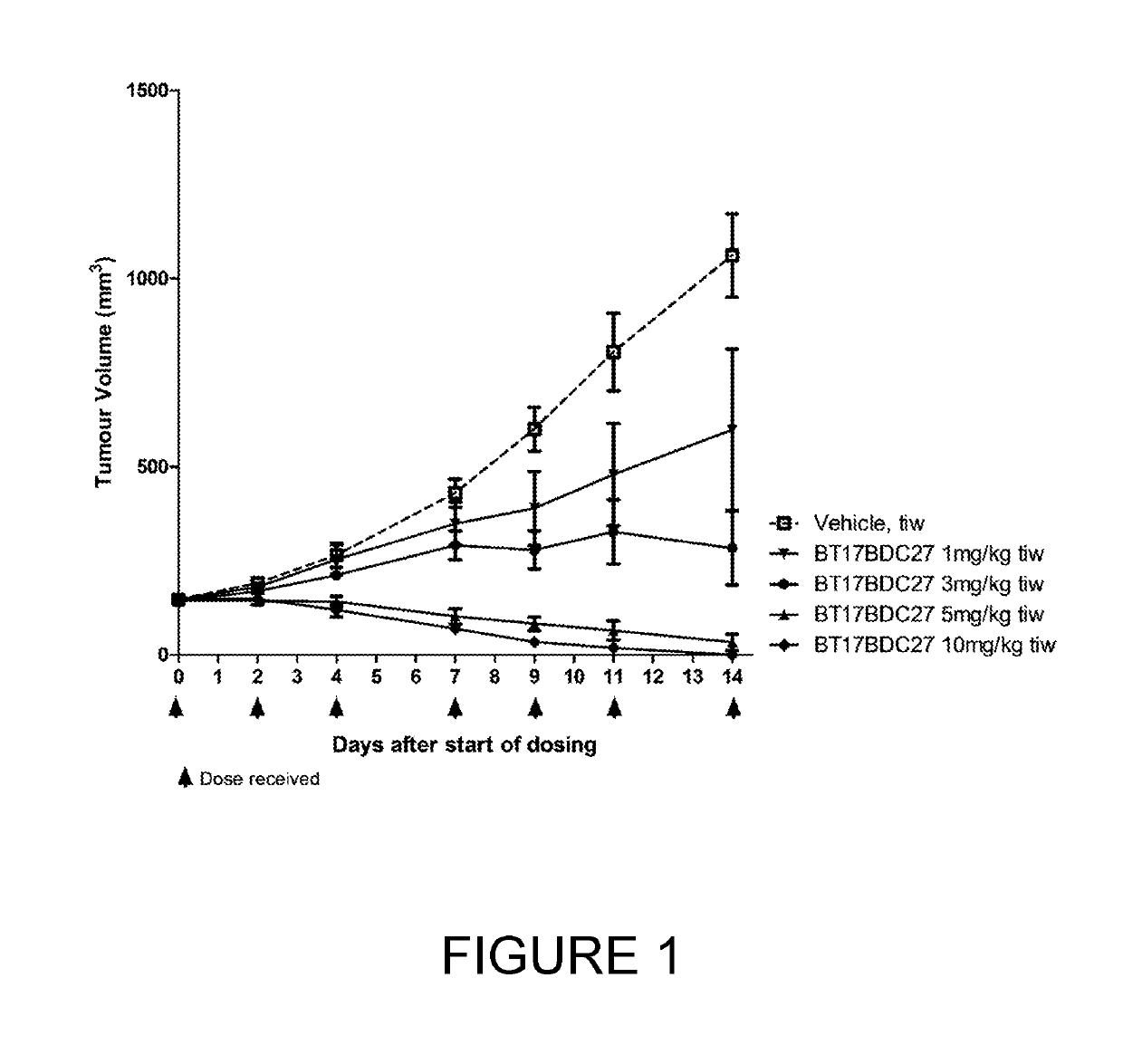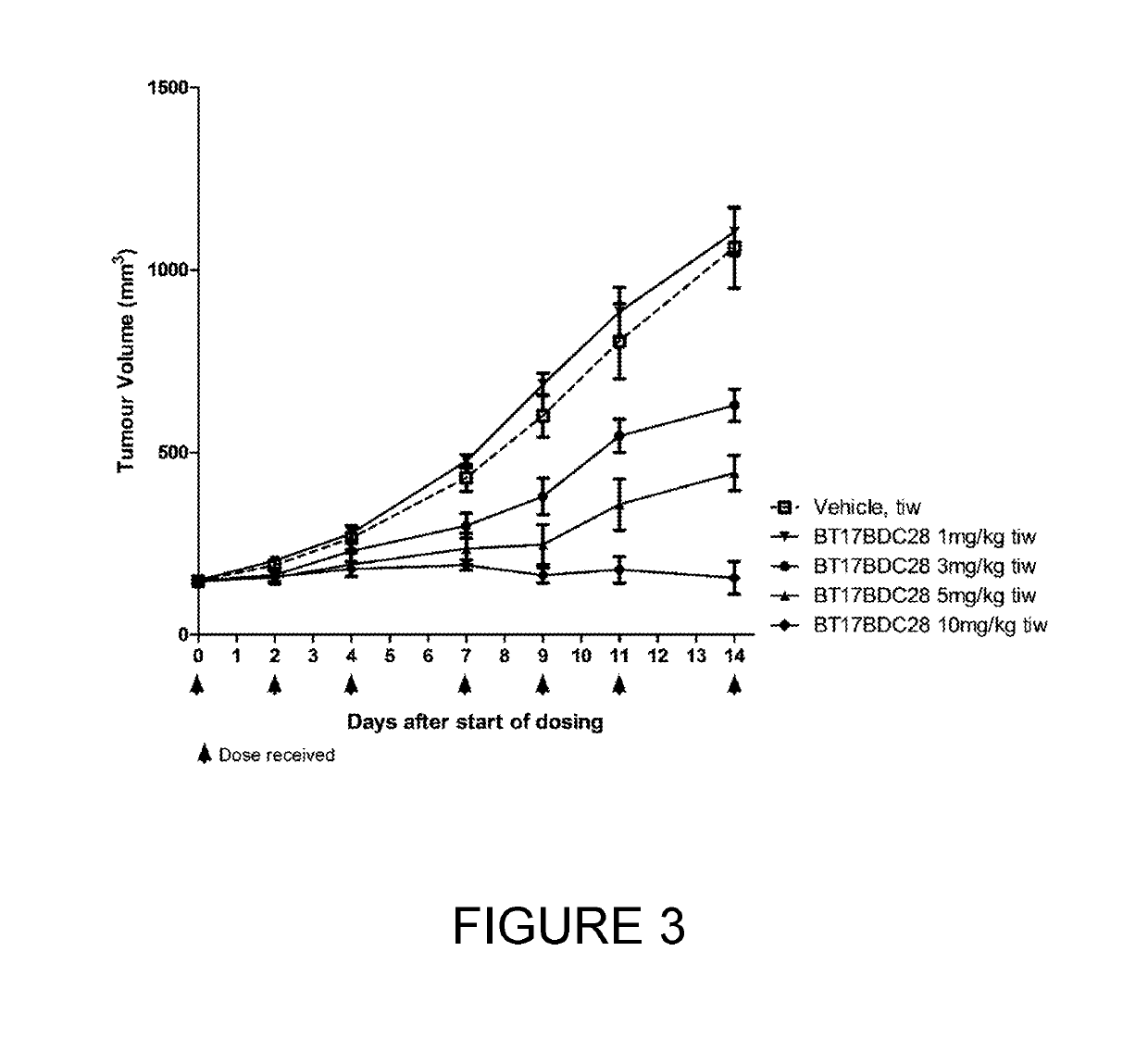Bicyclic peptide-toxin conjugates specific for mt1-mmp
a peptide-toxin and bicyclic technology, applied in the field of drug conjugates, can solve the problem of reducing the conformational flexibility of the cyclic structur
- Summary
- Abstract
- Description
- Claims
- Application Information
AI Technical Summary
Benefits of technology
Problems solved by technology
Method used
Image
Examples
example 1
Analysis of BT17BDC-27 and BT17-BDC-28
[0242]Two DM1-toxin BDCs were prepared (referred to hereinbefore as BT17BDC-27 and BT17BDC-28), whereby identical hindrance was introduced on the Bicycle side of the molecular construct. The hindering groups are methyl groups which are situated at the R3 and R4 positions.
[0243]BT17BDC-28 employs the bicyclic peptide 17-69-07-N241, which contains the bAla-Sar10 molecular spacer N-terminally attached the Bicyclic peptide containing the 4 modifications (D-Ala1 1Nal4 D-Ala5 tBuGly11).
[0244]BT17BDC-27 employs the bicyclic peptide 17-69-07-N268, which lacks the bAla-Sar10 molecular spacer N-terminally attached the Bicyclic peptide of 17-69-07-N241, while containing the same 4 modifications (D-Ala1 1Nal4 D-Ala5 tBuGly11).
[0245]The Bicyclic peptide sequences of 17-69-07-N241 and 17-69-07-N268, and their affinities to the MT1-MMP as determined by fluorescence polarisation competition experiments, are shown in Table 2:
TABLE 2Binding Affinities of 17-69-07...
example 2
Characterisation of BT17BDC-27 and BT17BDC-28
[0248]Both BDC conjugate structures were assessed for several in vitro parameters such as retention of potency to the human MT1-MMP hemopexin domain, stability in mouse, rat and human plasma, and stability to reducing agents such as dithiothreitol.
[0249]The data is summarised in Table 3 below:
TABLE 3In vitro properties of BT17BDC-27 and BT17BDC-28Bicycle DrugKd (nM)t1 / 2 (hrs)t1 / 2 (hrs)t1 / 2 (hrs)Relative StabilityRelative StabilityConjugate(Hemopexin domain)a(human plasma)b(mouse plasma)b(rat plasma)bto DTT (ADC)cto DTT (BDC)dBT17BDC-270.69 ± 0.26362391432(n = 2)BT17BDC-281.65 ± 1.082919131428(n = 2)where n = numbers of repeatsadetermined by fluorescence polarisation competition experiments using 17-69-07-N040 as a tracerbdetermined using quantitative LC-MS. Incubation time up to 24 hrs in plasma, containing 4 μM BDC.cfrom Kellogg et al (2011) Bioconjugate Chemistry, 22, 717. Note these values relate to antibody drug conjugates containing ...
example 3
fficacy of BT17BDC-27 and BT17BDC-28
[0251]Both BDCs were tested for their efficacies in in vivo mouse xenograft models, using the human lung squamous cell carcinoma line EBC-1.
[0252]BT17BDC-27 was more efficacious than BT17BDC-28, as it cleared tumours within 14 days (FIG. 1) at 10 mg / kg. A slight reduction in body weight was observable at this dose (FIG. 2). Conversely, at 10 mg / kg, BT17BDC-28 led to tumour growth stasis but not active regression (FIG. 3) while no weight loss was observed for BT17BDC-28 (FIG. 4). BT17BDC-27 merits further attention due to appreciable efficacy and tolerability at doses equal or lower than 5 mg / kg.
PUM
| Property | Measurement | Unit |
|---|---|---|
| Fraction | aaaaa | aaaaa |
| Volume | aaaaa | aaaaa |
| Molar density | aaaaa | aaaaa |
Abstract
Description
Claims
Application Information
 Login to View More
Login to View More - R&D
- Intellectual Property
- Life Sciences
- Materials
- Tech Scout
- Unparalleled Data Quality
- Higher Quality Content
- 60% Fewer Hallucinations
Browse by: Latest US Patents, China's latest patents, Technical Efficacy Thesaurus, Application Domain, Technology Topic, Popular Technical Reports.
© 2025 PatSnap. All rights reserved.Legal|Privacy policy|Modern Slavery Act Transparency Statement|Sitemap|About US| Contact US: help@patsnap.com



